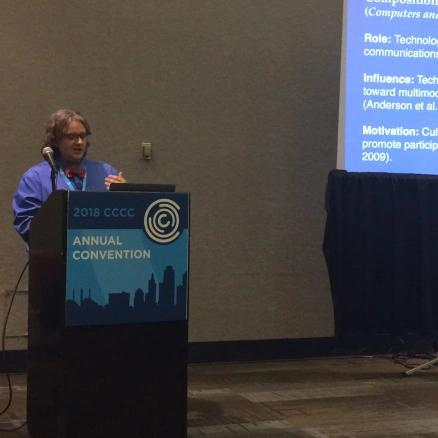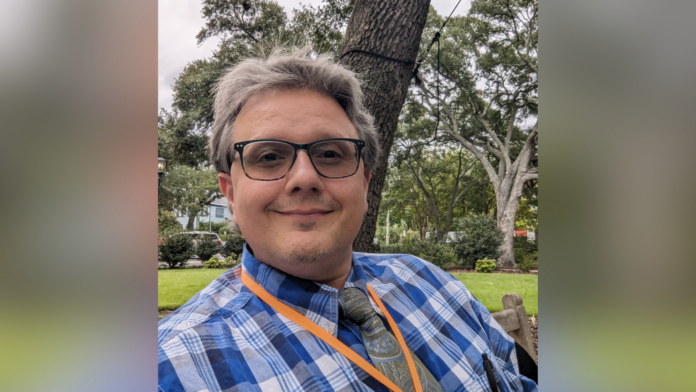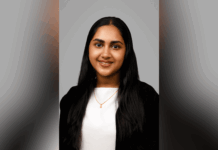Dr. Philip Gallagher is working to make online communication more useful, usable and accessible for everyone, regardless of their sensory or physical abilities. Through his independent research as well as projects involving students, he is helping to improve user web experiences and educate the next generation of professionals who will continue these efforts.
Dr. Gallagher, assistant professor of technical communication in the School of Engineering, came to Mercer in 2020 from the Midwest. He holds a bachelor’s degree in English and a master’s degree in composition and rhetoric, both from Eastern Illinois University, and a Ph.D. in rhetoric and professional communication from Iowa State University.
For about a decade, he has studied how users interact with written, oral and visual electronic communications, and he began to focus on making web experiences more accessible for people with different sensory issues a few years ago. While working on his dissertation, an injury left him with blurry vision in one eye for about a year, showing him firsthand how difficult it can be to use screens to access information.
“I have had family members who had hearing impairments and things of that nature, but to experience it firsthand and then have that as a point of reflection emboldened me to really take it on,” Dr. Gallagher said.
His “access-first approach” makes accessibility a priority in online projects from the beginning stages, rather than an afterthought.
“I call it ‘information justice.’ It’s essentially making sure that the information is equitably experienced by everyone,” he said. “Whether they might have a limitation in perception, operation or understanding, I really try to make sure that everyone can interact with the communication.”
Website usability issues may seem a minor inconvenience to some, but for others, they can be an insurmountable barrier. A simple example is a smartphone popup window that can only be closed by clicking what seems to be a microscopic X. This can be a difficult task for anyone, let alone someone with a fine motor disability. Usability and accessibility issues affect everyone, and that’s why this research is so important, Dr. Gallagher said.
Smartphone popup windows are “just the tip of the iceberg” when it comes to usability errors. Utah State University’s Institute for Disability Research, Policy and Practice found an average of 50 accessibility errors per page in its 2023 evaluation of homepages for the top 1 million most-visited websites.

Other common errors include missing alternative text for images, which describes pictures to visually impaired users; no video captions or audio descriptions; poor color pairings that make visuals hard to see; complex or abstract writing or visuals that make information unclear; confusing navigation systems and menus; inconsistent page design across a website; and the use of drag-and-drop boxes and functions that require long swiping motions.
Technical communication students have the opportunity to get involved in some of Dr. Gallagher’s research. Since 2022, he and Dr. Amro Khasawneh, assistant professor of industrial engineering, have been working with the Global Partnership for Telehealth to make its Pathways health care app more accessible.
Currently, six of their students are focusing on improving neurocognitive access and understanding of the written information as well as motor mobility compliance research, while a seventh student is homing in on the visual components of the app design.
This semester, Dr. Gallagher took the reins of a project with the U.S. Department of Homeland Security that was started eight years ago by Dr. Pamela Brewer, professor and chair of technical communication. Students in his usability course are working to improve the usability and accessibility of a selection of Homeland Security sites.
“It’s impossible to be perfect, but it is possible to strive to make it better and better and better,” he said.

Dr. Gallagher also has partnered with Dr. Bremen Vance, assistant professor of technical communication, for two research projects related to artificial intelligence. The first is looking at AI’s impacts on the graphic user interface and how people access their devices. The second is exploring generative AI in instruction, including through the development of a new research platform.
In addition, Dr. Gallagher, Dr. Vance and Iowa State University professor Dr. Charles Kostelnick are working on a new edition of the textbook Designing Visual Language that will include more accessibility information.
Dr. Gallagher has given a number of presentations on usability and accessibility topics in recent years. He and wife Marci, who is also passionate about accessibility work, presented at the 2021 virtual conference for the Association for Computing Machinery’s special interest group on document design, the 2022 Society for Technical Communication (STC) Summit, and a meeting for the STC Atlanta chapter’s accessibility special interest group.
He also contributed to research on enhancing Americans with Disabilities Act compliance for websites that Dr. Khasawneh presented at the 2023 Human Factors and Ergonomics Society Annual Meeting. At the Institute of Electrical and Electronics Engineers Conference in July, Dr. Gallagher will present “Enhancing the accessibility of information in web apps through motor mobility testing” with student Michael Griffin, as well as a talk on user experience design pedagogy with Dr. Guiseppe Getto, associate professor of technical communication.
“My long term goal is to make communication more useful and usable and accessible for every body,” said Dr. Gallagher, emphasizing “every body” as two words. “I want information access to be equitable. I want everybody to have fair and equal experiences so that no matter what perception, sensory abilities they have, they perceive the information the same way. They’re not missing anything no matter how they interact with that information.”
Dr. Gallagher wants to help lay a foundation for teaching people to do this same accessibility research, so the next generation of STEAM (science, technology, engineering, art and science) professionals can continue to make advances in this work.









